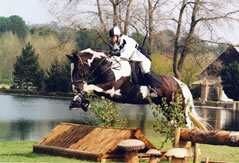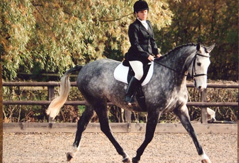
Vaccinations
We strongly advise routine vaccinations for your horse to protect them from debilitating and sometimes fatal diseases such as Influenza, Tetanus and Equine Herpes Virus.
Every horse should be vaccinated against Tetanus. The vaccine is very effective and very cheap. Tetanus is a bacterial disease which occurs when a wound becomes infected with bacterial spores that are found everywhere in the soil and proliferate in conditions of low oxygen concentrations. The site of the wound is often invisible. The bacterium produces a powerful neurotoxin which causes the muscles of the body to go into spasm resulting in a rigid posture, stiff gait, lockjaw and an inability to eat and drink. Horses are particularly susceptible to tetanus and the disease is usually fatal after a prolonged period of distress, pain and ultimately death due to paralysis of respiratory muscles. The first primary vaccine is recommended from 4 months of age in foals from unvaccinated mares and from 6 months of age in foals from vaccinated mares. A second primary dose is given 4-8 weeks later and the first booster 12 months after that. Thereafter, boosters are recommended every other year, often given in combination with the flu vaccine.
For unvaccinated animals that sustain injuries such as lacerations or foot abscesses, temporary protection lasting approximately 6 weeks can be provided by injecting Tetanus Antitoxin (TAT). This may also be used to protect newborn foals from unvaccinated mares. TAT is an expensive drug that does not provide long term protection. It is a false economy and potentially very dangerous not to vaccinate against tetanus. In particular, please ensure that your horse has completed the primary tetanus vaccination course before considering any planned surgical procedure such as castration.
Equine influenza (flu) is a highly contagious disease that affects the respiratory tract of the horse and spreads rapidly in groups of horses in environments such as training stables, livery yards, at competitions or on the hunting field or fun ride. After exposure to the virus, symptoms usually appear within 1 to 3 days and infected horses can spread the virus for several days. Signs of ‘the flu’ include loss of appetite, depression, nasal discharge and a high fever, developing into a dry cough that may persist for several weeks. Uncomplicated infections tend to show improvement in clinical signs within 7-10 days.
Vaccination against influenza is strongly recommended for any animals that regularly mix with other horses and it is obligatory for several equine activities, ranging from the smartest racecourse in the land to Pony Club camp. The format of vaccination must follow the Jockey Club Regulations. Please note that these regulations are different to the recommendations of the vaccine manufacturers.
Jockey Club (FIE/BHS) Regulations:
| First Primary Injection | Day 0 |
| Second Primary Injection | 21-90 days after First Primary |
| Third Primary Injection | 150-215 days from Second Primary |
| Annual Booster | 365 days or less from Third primary or from last booster. Anniversary date is acceptable. |
If any injection is overdue (even by 1 day), it is necessary to start the whole course again, so please ensure that you do not miss your horse's vaccination date. We do offer a complimentary reminder service, but this service is reliant on computer systems and the postal service and is not foolproof – It is your responsibility to put the vaccination date on your calendar and to book an appointment in time for the vaccine due date.
No horse may be presented at a race meeting whose vaccination was given less than 10 days previously. Horses competing under FEI Rules are required to have had an influenza vaccination within 6 months + 21 days of the date of arrival at the FEI event and they are not permitted to have had an influenza vaccine within 7 days of the date of arrival at the FEI event. Full details area available at http://www.fei.org/veterinary/vaccinations-and-health-requirements
We generally recommend resting animals for one or two days after flu vaccination.
Equine Herpes Virus (EHV 1 and EHV 4) is an infectious viral disease which may cause respiratory disease, paralysis or weakness, abortion in pregnant mares and death of newborn foals. It is a very common virus and is spread through nasal discharges from infected horses, through aborted foetuses and via indirect contact with handlers and shared equipment. Symptoms may include fever, a clear nasal discharge, coughing, swollen glands, loss of appetite and depression. Symptoms tend to be less severe than those of equine flu. As with shingles or cold sores in humans (both herpes viruses), ‘latent’ or dormant infections can occur and may be reactivated years later after periods of stress. For protection against respiratory or neurological disease, the first primary vaccine is recommended at 5 months old, followed by a second primary dose 4-6 weeks later and boosters every 6 months. Pregnant mares should be vaccinated during the 5th, 7th and 9th months of pregnancy.
Other less commonly used vaccines in horses include Rotavirus given to pregnant mares to protect the foal at birth from diarrhoea and Equine Viral Arteritis (EVA) given to breeding stallions to prevent the spread of EVA during mating.




